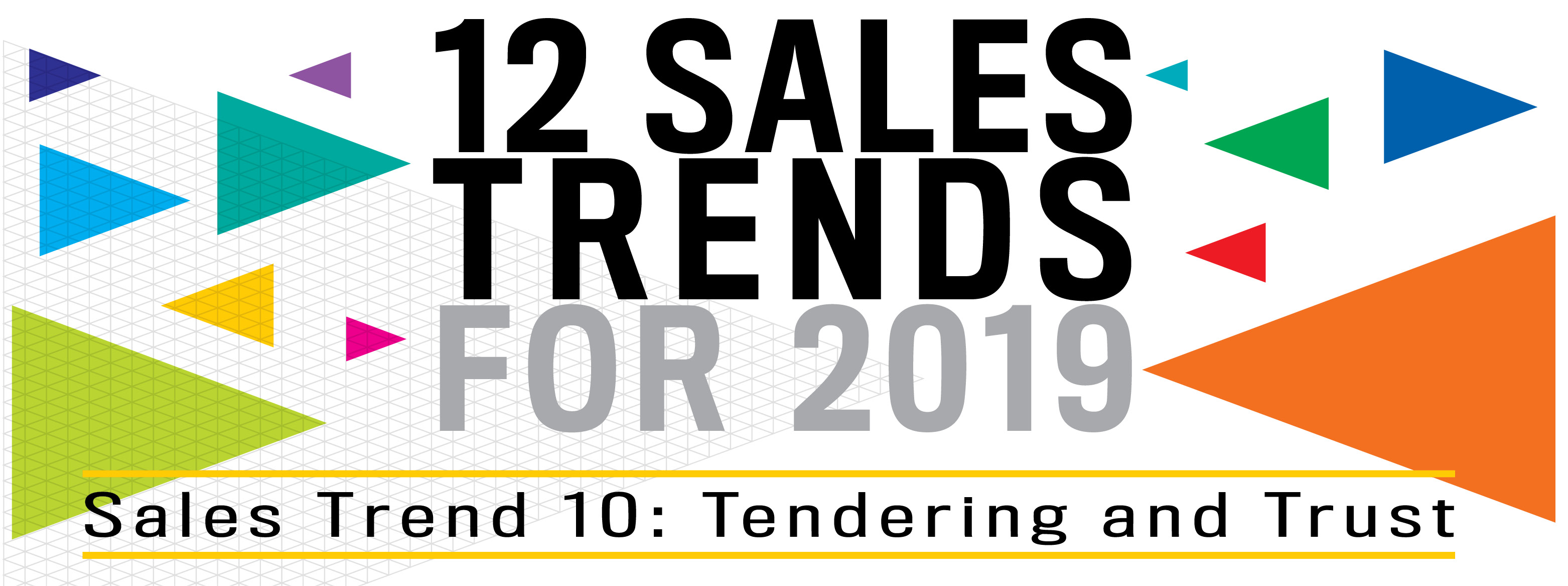
Sales trend 10 from the Barrett 12 Sales Trends Report for 2019 is about the importance of trust when writing tenders that win.
By guest authors David Lunn and Kelly Richmond, Bidwrite
Building BID BELIEVABILITY
Developing tenders and proposals is key to winning and retaining business through contested sourcing processes. Most buying organisations, government and commercial, use these types of processes in one form or another. So there really is no escaping the need to produce written communications to, at least in part, persuade a client or prospect to choose us.
Data emerging from the USA, mirrored by BidWrite’s own win/loss tracking, shows that approximately two thirds of ‘liked’ incumbent organisations – those organisations already delivering the product or services – re-win tenders.
This relates to the processes and practices buying organisations use to evaluate tenders and make award decisions. Despite overtly ‘quantitative’ scoring schemas and guidelines, if you look behind these processes there is always a degree of personal judgement being applied to the evaluation and scoring. So, even inside probity laden processes, how you are evaluated is, at least in part, a function of how you are perceived.
These tendering process characteristics reinforce an important work wining principle: organisations buy from organisations that they trust and believe capable of delivering the requisite goods or services. Expressed in other words, they make sourcing decisions based on perceived risk, which can sometimes even override lowest cost or cheapest pricing considerations.
This is intuitively true of course. We all typically behave in this way because we want to do business with people and organisations we like and trust. Business development and sales professionals are acutely attuned to this point, too.
However, over recent times we have seen an increase in the number of unsolicited, or unexpected bids appearing in suppliers’ inboxes.
So, how can we systemically produce tenders and proposals that compel buyers to choose us instead of our competitors if they don’t know us? We need to make our bid more believable than those prepared by our competitors. Believability engenders trust which, in turn, lowers perceived risk.
This trend sees smart companies creating trust before the bid is released, building it into their submission and reinforcing it during the post bid activities.
DEVELOPING trust before BID documents are released
POSITIONING FOR SUCCESS
Being in a winning position before a tender or proposal invitation is issued is the single most important predeterminant for bidding success. Positioning, in a tendering context, primarily involves relationship building with your client before the bid is released. By doing this well, you will gain a better understanding of your client’s key needs and issues, be they disclosed or not. This knowledge permits reflecting real insight and demonstrating genuine empathy in the subsequent tendering stages. Having your client nodding along as you play back to them your understanding of their issues and challenges is essential to developing trust.
Another benefit of meeting your client/prospect beforehand is that you can introduce your capability and solutions to them and have this tested and validated ahead of being formally adjudicated. Again, this will help demystify your business and help break down the natural scepticism most buyers associate with new and unfounded information presented to them.
This is why good performing incumbent contractors and suppliers have a huge natural advantage. Clients trust them automatically because they are performing the work or delivering the goods. Unfortunately, many incumbent organisations fail to recognise that Day 1 of delivering the new contract is also Day 1 for positioning for the next one.
We have attended recent APMP conferences in the USA and noted that there’s a trend amongst wise selling organisations of equipping their service delivery and account management personnel with relationship development and influencing skills. They recognise that these people are actually front-line business developers, but they may not be adequately skilled to perform this role.
If you have built client trust early enough, you may also be able to influence buyer requirements. This is business development and positioning nirvana. But it only happens if your client or prospect genuinely believes your offer will best meet its needs.
Positioning is essential to winning work. So no positioning is a tendering red flag.

If the first time you hear of a tender opportunity is when it lands in your inbox, from a client you have never worked with, building requisite trust is difficult. If this is the case, you need to really consider whether you should be bidding.
However, if you do decide to bid, even if you aren’t well positioned, then there are still ways to build trust as part of the written submission. These techniques are described below.
Developing compelling written documents
Getting the basics right
The first and most straightforward trust building practice in tendering is to comply with all the requested tender instructions and requirements. Non-compliant responses basically tell the reader that you are unable to do what is required and it also puts your submission at risk of being ruled out.
Don’t lose the trust of your prospect at the first hurdle by not paying attention to their basic submission requests. Always fully and comprehensively answer questions. This creates the best possible platform for framing your benefits, maximising tender evaluation scoring and shifting decision making away from price as much as possible.
Persuasive writing techniques to COMPEL YOUR CLIENT
The second bidding trust building technique relates to what you write. When responding to tender and proposal requests, most organisations write about what they are going to deliver or do. This is OK, because buyers want to know this.
But they forget to also articulate to the client that they understand what the client is trying to achieve and prove why their solution/ approach/ people/ technology etc. are different to, and better than, their competitors’. This additional tender response content is not marketing ‘fluff’, unsubstantiated claims or sweeping generalisations. It is a targeted content of compelling stories that set you apart from your competitors in a believable way, based on the following four techniques.
- Clearly articulate that you understand the client’s key drivers/issues
Get behind the words written in the client’s request document and get to the heart of what your client believes will really make a difference.
Articulate these issues in your submission in your own words so that your client knows you understand it. If you do not know what matters, how can you provide the best solution?
If you haven’t been able to position yourself but are still wanting to bid, you need to make educated guesses as to the client’s likely pain points and issues. This could be based on market research or feedback received through the tendering process (e.g. answers to clarification questions). Your issues might not totally hit the mark, but at least if you attempt to show insight and empathy you will be perceived as better than a competitor that has not bothered to do this.
- Provide a targeted solution that addresses your client’s issues
Most organisations focus their tender writing energy explaining to clients ‘how’ they will do the job. Often though, this provides general solutions or approaches rather than responses that tie in directly with the key drivers or issues of the client. Prepare answers targeted to the questions in context of the issues. If you get this right, it will demonstrate to your client that you understand their requirements and promote your believability.
- Articulate the benefits the client will receive from your solution
Detailed ‘how you are going to do it’ tender content is vital. But don’t assume the benefits of your solution or approach are obvious. This is a common trap, because we often take it for granted that the benefit is implied or readily identifiable by the reader. For example, you might say something like ’…our proposed team has direct experience in your industry’. The implied benefit here is that the industry experience translates into engagement speed, thoroughness, lack of learning curve, etc. so say this plainly and eliminate the risk that a less informed evaluator treats the statement as a generic non-believable claim.
- Prove your benefits
Evidence and proof underpin tender credibility and trust. You simply have to back up your tendered statements with proof at every possible opportunity.
Tender and proposal proof comes in all shapes and sizes. Basic examples include recent, relevant reference projects, case studies, testimonials and referee details. Better examples include quantified and independently verified facts and figures, as well as awards and recognition from credible third parties.
Often tender request documents specifically ask you to provide proof type information. Naturally, you will comply with this request. But better tendering organisations realise that proof needs to be woven throughout the whole document to constantly reinforce believability, not just in the ‘previous experience’ and ‘referee details’ parts of the response.
TRUST REINFORCING during POST-BID activities
For shortlisted organisations trust continues through presentations and negotiations if they are well organised, honest and transparent. Typically, by the time you get to pitch or present following a written submission the evaluators are usually validating their decisions, not still deciding. Make sure you keep on reflecting your client centricity, benefits and proof points to continue driving home believability and generating trust.
TRUST WINS
The trend in bid writing is that now, more than ever, trust wins. The winning tender formula is simple: You show the client you best understand what they need, and they trust your ability to deliver more than your competitors.
Building this trust takes time. This trend sees smart organisations that win tenders more often than others consciously factor believability and trust building into the tender and proposal writing process as much as they focus on relationship building competencies for their sales force.
BidWrite’s view is that whilst procurement models and tools will continue changing, and submission sophistication increases, generating and reinforcing trust will remain pivotal to tendering success.
Remember everybody lives by selling something.
Related topics
12 Sales Trends for 2019 – Trust me, I’m in Sales
Should clients pay for tenders and RFP submissions?
A year ago (roughly)
7 things we need to know about the craft of selling


New Article Email Notification